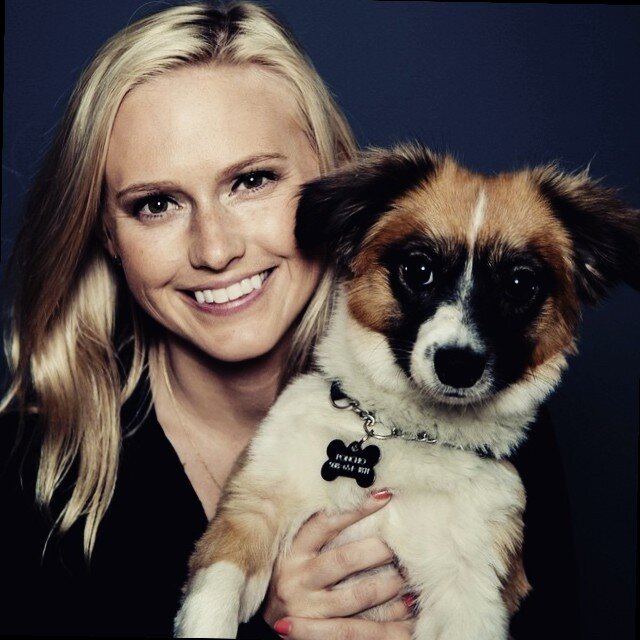The life and timelines of research projects

 When I was first starting as a user researcher, I had no basis of understanding how projects worked in tech companies. The only mental model I had of research was academia. I was unable to find examples of research projects online and had no idea how they worked. Eventually, I learned that once I saw research in action. However, it would have been highly beneficial for me to understand the overall process beforehand.
When I was first starting as a user researcher, I had no basis of understanding how projects worked in tech companies. The only mental model I had of research was academia. I was unable to find examples of research projects online and had no idea how they worked. Eventually, I learned that once I saw research in action. However, it would have been highly beneficial for me to understand the overall process beforehand.
For those who have not yet worked in a tech or product company, it can be hard to envision what projects would look like. Previously, I wrote an article about a week in the life of a user researcher. With this article, however, I will shine some light on a seemingly mysterious process only available behind closed doors.
Let’s begin
Imagine you are working at Best Friends Animal Society, an animal welfare organization in America dedicated to ending companion animal deaths in shelters.
Sidenote: if you have a chance to volunteer there, I highly recommend it!
Second sidenote: tears came while writing this article due to my absolute love for animals. If you are looking to do a portfolio piece, consider volunteering for a charity or non-profit organization!
You are a user researcher at this organization. You work with different departments, but primarily tech, product, and marketing. You are continually working with product managers, UX designers, and developers to empower teams to make the best decisions for the organization.
Usually, your research projects come to you in two different ways:
- From precious research insights
- From an internal stakeholder
For this project, we will focus on the second. A research project lands on your desk from one of the product managers. Recently, we have seen a drop in the usage of the “adopt” area of the website. The product manager looked at Google Analytics and saw a considerable decrease in time on page and click-thru rate. The team in charge of that functionality wants to understand what is going wrong.
What would you do?
The life of a research project
Before we dive into the timelines with this project, it is essential to look at the holistic life of a typical user research project.
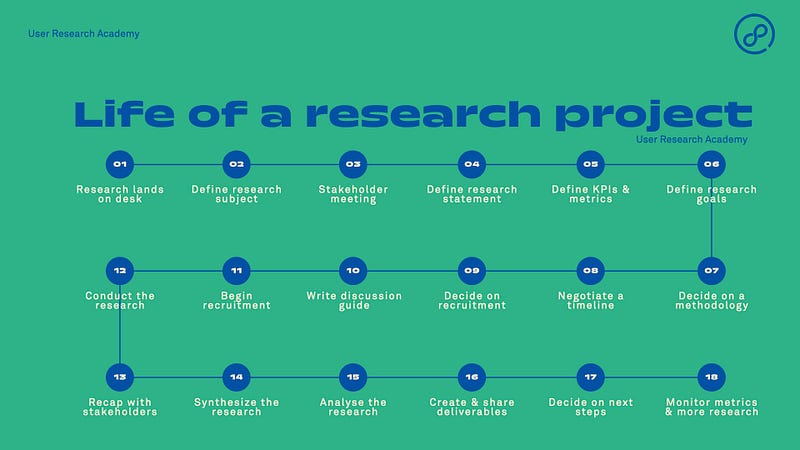
I want to stress that this is a typical journey and research won’t always happen in such a linear (and clean) fashion. Often, you have to skip straight to recruitment because of timelines or conduct research while recruiting. This overview is simplified but gets the overarching message across of the steps a researcher generally takes during a project.
As you can see, before you jump right into research, you go through the steps of really understanding and defining the problem and goals of the study. You are meeting with stakeholders to ensure alignment and answer clarifying questions.
Arguably, steps 1–6 are the most important as they drive the project in a particular direction. For example, the research statement and goals help define the methodology, recruitment, and the discussion guide. This building block effect is why it is vital to take these steps before diving into research.
For the ease of this article, let’s come to some conclusions:
Research statement:
- We want to better understand the user’s mental models when it comes to animal adoption to improve our current website
Research goals:
- Understand how users are thinking about adoption, in general
- Uncover how users are currently interacting with the adoption feature on our website
- Identify pain points in the adoption process, in general, and on our website
- Discover other apps/websites users are interacting with to adopt animals and their experience with them
Now comes the picking of methodologies. I have previously written on this subject, and it is a difficult one to explain. However, you use your goals to help guide you to the write methodology, which lands in one of three buckets:
- Purely generative research
- Purely evaluative research
- A hybrid between generative & evaluative research
Here is a high-level and simplified process I go through when deciding:
- Are we looking to understand mental models, frustrations with current methods, or how users think about concepts in general? Are we looking agnostic of our product? -> Generative research
- Are we trying to evaluate how users are interacting with a prototype or live product? Are we looking to see pain points associated with our particular product? -> Evaluative research
- Is there a mix of both? -> Hybrid research
Once I place the goals into one of these three buckets, I can decide on the methodologies that would help answer these goals. The most common associations are:
Generative research
- 1x1 in-depth discussions (aka interviews)
- Contextual inquiry
- Mental models
- Customer journey interviewing
- JTBD
Evaluative research
- Usability testing
- A/B testing
- Competitive testing or analysis
- Benchmarking
- Surveys
Hybrid
- 1x1 in-depth discussion + usability testing
- Card sorting
- 1x1 in-depth discussion + follow-up survey
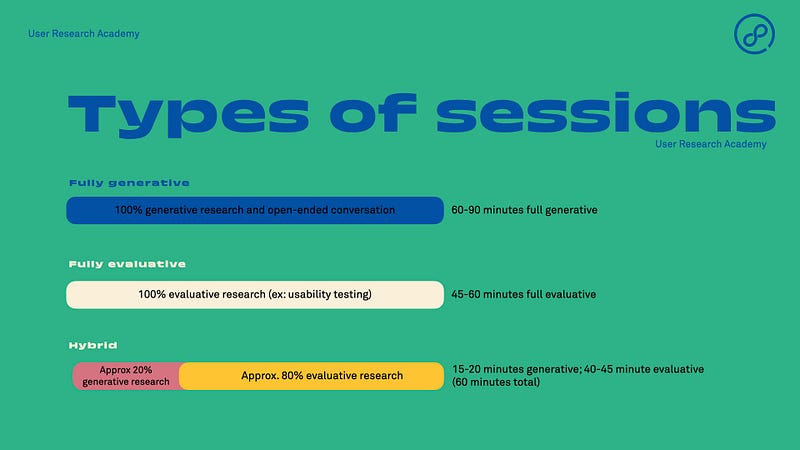
Timeline of a typical project
The timeline of a typical project can be over three to six weeks. As mentioned above, it can include just generative research (which is about four weeks total) or just usability testing (which is about three weeks). Another standard timeline is conducting generative research to understand the problem, and then creating insight-based prototypes to usability test.
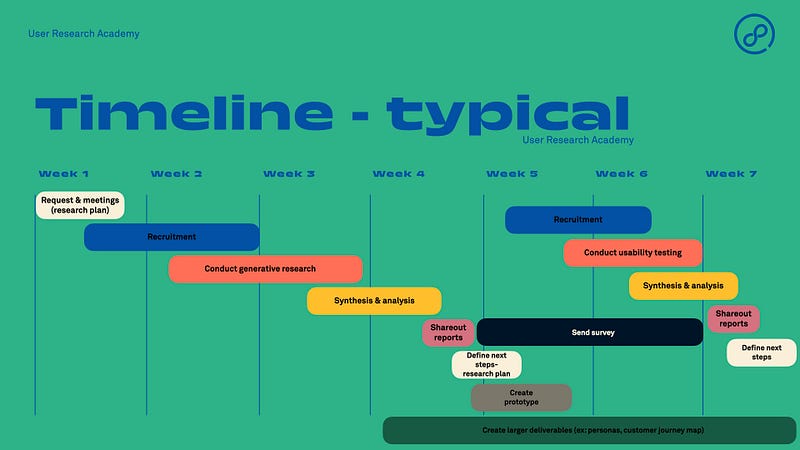
As you can see, in the above image, you decided to run two separate studies. First, you run a 1x1 in-depth discussion to understand the following goals:
- Understand how users are thinking about adoption, in general
- Identify pain points in the adoption process, in general
After, you run a usability test to cover the following goals:
- Uncover how users are currently interacting with the adoption feature on our website
- Identify pain points in the adoption process on our website
- Discover other apps/websites users are interacting with to adopt animals and their experience with them
In this evaluative study, you may also offer prototypes for users to test in addition to looking at the current live product. Or, you may have to run a separate evaluative study to test those prototypes.
Timeline of a hybrid project
Slightly different from a typical project is the hybrid project. I love hybrid projects; they are my absolute favorite types of studies to run. I feel like I get much more accomplished in each session than with the typical project timeline. I also use hybrid projects to highlight the importance of generative research.
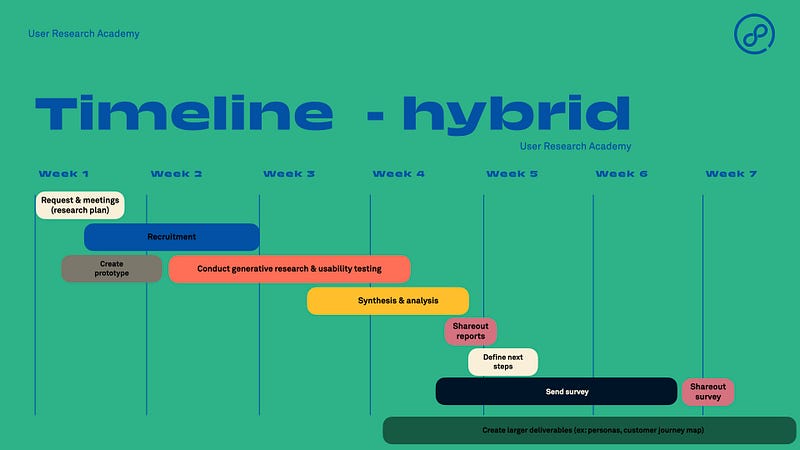
In this instance, you run a more extensive study, including generative and evaluative research. In one session, you are conducting a 1x1 in-depth discussion followed by a usability test. In this study, you can answer the following goals:
- Understand how users are thinking about adoption, in general
- Uncover how users are currently interacting with the adoption feature on our website
- Identify pain points in the adoption process, in general, and on our website
- Discover other apps/websites users are interacting with to adopt animals and their experience with them
While I prefer hybrid projects, they are more advanced than the typical approach where you tackle one method. Hybrid projects take more careful planning and time management. While you are practicing and honing your craft, I recommend starting with a regular timeline and making your way to hybrid.
These timelines are not rules!
As I mentioned, these steps and timelines are ideal. You may have to do lean research in two weeks, or you might not have the budget to run two or three separate studies. In this case, you will have to choose between generative and evaluative research. Additionally, you may already have previous research the team could look into to answer the questions.
I offer these graphs and steps as guidance towards your next research project. They are not hard and fast rules to live by, and I encourage you to find the best process for yourself and your organization.
If you’re interested in joining an awesome community of user researchers, join the User Research Academy Slack. If this article piqued your interest, and you would like to learn more, check out the courses and webinars I offer.

